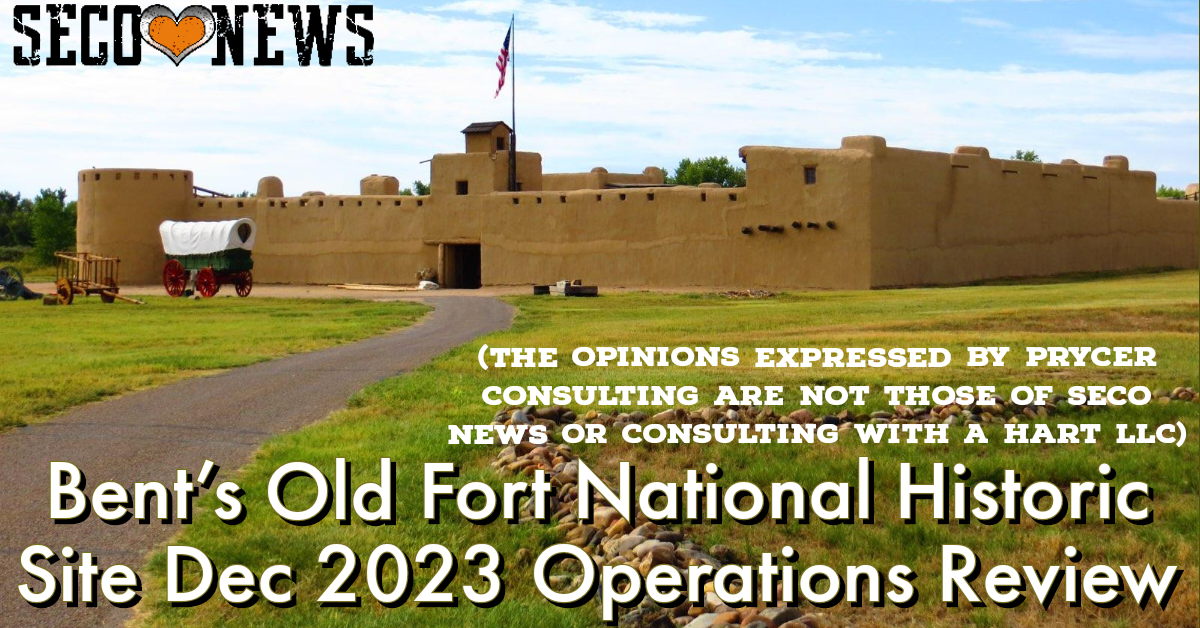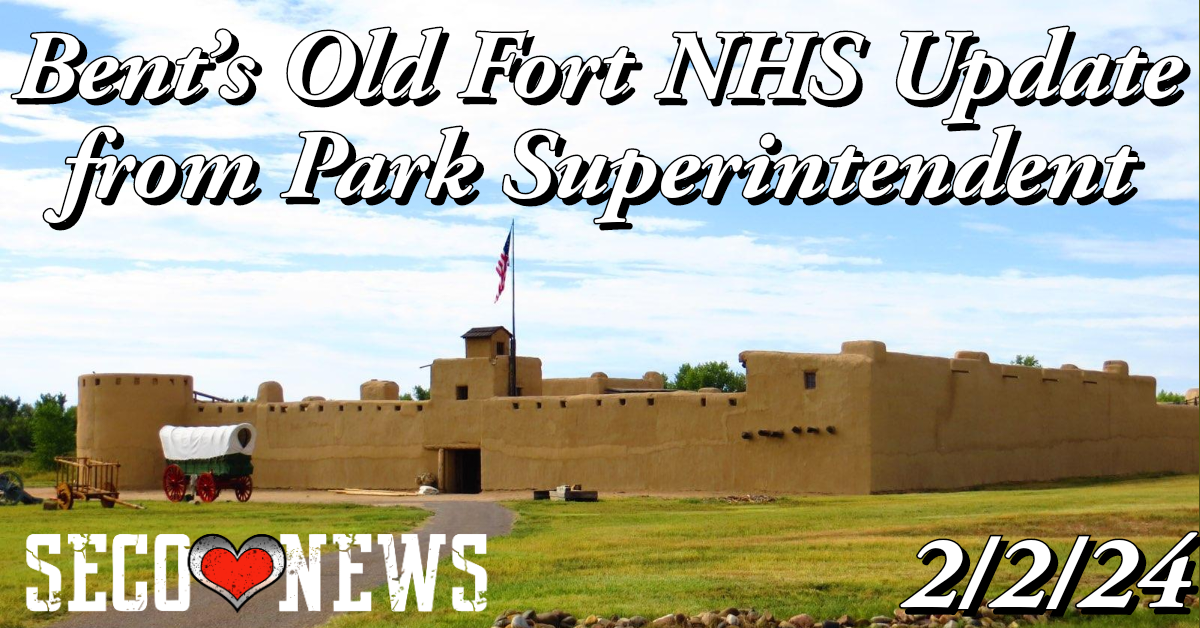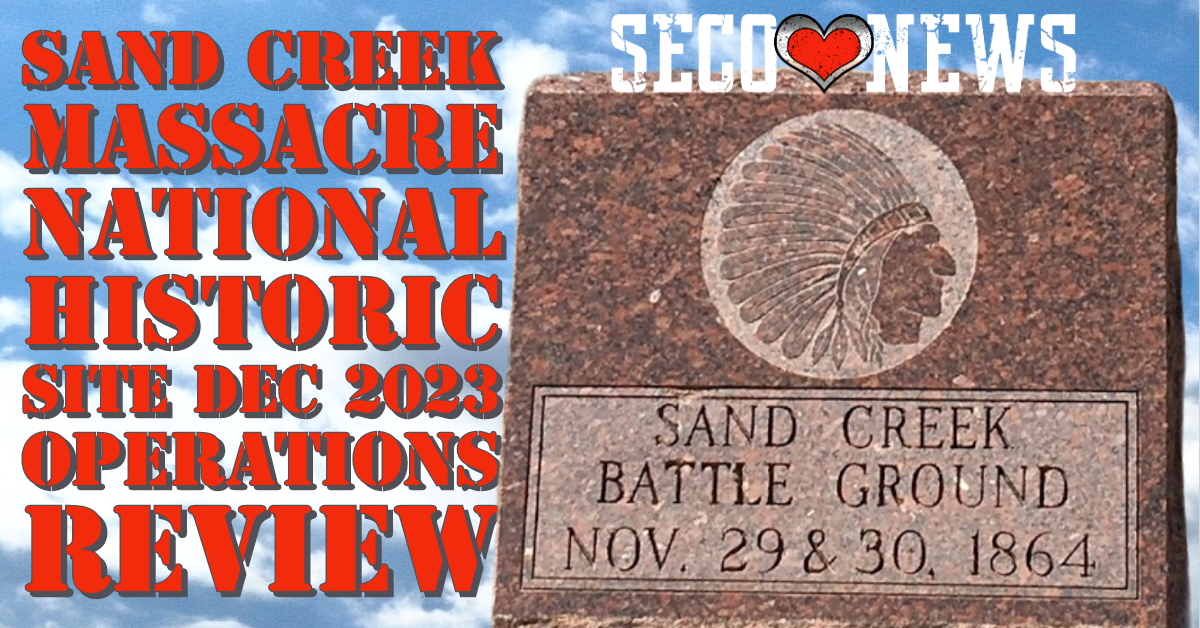Bent's Old Fort National Historic Site Dec 2023 Operations Review by Prycer Consulting

Description: Prycer Consulting was Contracted by the National Parks Service to Perform Operations Reviews on Bent's Old Fort, Sand Creek Massacre, and Amache NHS. Their Staffing and Interpretation Assesment for Bent's Old Fort NHS Released December 2023 Follows... (The opinions expressed by Prycer Consulting are not those of SECO News or Consulting With A Hart LLC)

This document was obtained from Highplains District Superintendent Eric Leonard.
Bent's Old Fort National Historic Site
"In Fall 2023, Prycer Consulting was hired to do a general interpretation and staffing assessment for three sites within the High Plains Group: Amache National Historic Site, Sand Creek Massacre National Historic Site, and Bent's Old Fort National Historic Site. The site visit was conducted in mid-November, just after important changes for the site were announced: the entire second floor of the Fort was closed to visitors due to safety concerns and Director of Interpretation Alicia Lafever announced her retirement at the end of the year. These changes come shortly after a new superintendent, Eric Leonard, came to the High Plains Group in early summer. With fresh eyes already at the site-and more fresh eyes on the horizon, the time for assessment was ideal."
While Prycer Consulting didn't do the official tour of the fort, she did talk with multiple frontline staff members, toured the fort, and met with administrative staff. Tour notes, the foundation document, policies, and program scripts were shared with her in advance. During these conversations, one critical question emerged: How can we begin to diversify the methods of interpretation at Old Bent's Fort?"
Living History: The Staff
"In recent years, many historic sites have begun to face the limitations of living history. From the visitor perspective, some visitors simply don't like this method of interpretation and may actively avoid it. Visitors learn in a variety of ways, and many visitors prefer going at their own pace. It can take valuable time for a visitor to understand the guiding principles around living history, which may prevent them from fully participating. Some people may prefer to explore on their own before interacting with a Ranger. Of course, one of the big advantages of living history is the conversations between visitors and staff, as they learn from each other. The question was asked: what are the ways visitors can learn at the Fort that aren't dependent on people? Can you still spark conversation? Staff pointed to brochures available at the main entrance: the official 'unigrid' brochure (last updated in 2016), the self-guided tour brochure written in 2002 and last updated in 2022), an orientation video (2005), and a touch-screen interactive with additional information about specific topics."
"However, once a visitor starts exploring the Fort, the options are limited. None of the historic spaces have any type of signage or interpretive material. Are there minor interpretive interventions that can still spark conversation? Is there a way to take some of the hands-on activities that staff run and make them self-guided? There are lots of opportunities to provide additional depth to the current historic spaces, and it's worth exploring various options. In addition, as staff are facing a years-long closure of the second level, adding more learning opportunities should help assuage visitor frustrations with not being able to see everything."
"Recommendation: Take one room. Assign a small budget-no more than $250. Let staff identify and create interpretive interventions that will either spark curiosity or conversation-or both."
"There are other limits to living history. From an operational perspective, living history programs are an expensive, ongoing investment. Finding individuals that are willing to work a difficult job for low pay in all sorts of weather has always been challenging, and it's become harder in recent years. Often, sites are unable to invest the proper resources into training, leading to disappointing visitor experiences. Without additional interpretive tools in the toolbox, when someone is absent, it's almost like closing an exhibit. In addition, the act of doing living history can create some unusual staff dynamics. Staff mentioned some tension between those frontline staff that only wear historic clothing and those that occasionally wear the NPS Ranger uniform. Additional hierarchies emerge, as well as limitations based on 19th century ideas around gender and race. These tensions are also derived from the fact that living history practitioners are mostly white men."
"Recommendation: Begin shifting living history from being the primary interpretive tool to a supplemental tool. The first step should be an interim interpretive plan, completed as soon as staffing resources allow."
"Finally, living history has serious limitations when considering diverse stories. In the past, not everyone experienced Bent's Old Fort in the same way-and that continues to be true. Many people express regret that more people of color don't participate in living history-but is the past a comfortable place for them to work? Is the past a comfortable place for all your visitors? From a mental health standpoint, it is far more beneficial to stop trying to take people to the past, but rather help visitors observe the past. Best practices in living history are evolving rapidly. Visitors need a framework in order to understand what's happening. Many sites are becoming far more intentional in how they use living history. The emerging best practice is to conduct formal living history programs, with a defined structure such as:"
* "A third-person introduction, up to 7 minutes. This sets the stage for what's next."
* "A living history scene or monologue, up to 20 minutes."
* "A third-person conclusion, wrapping up key ideas and inviting visitor feedback and questions."
"Sites are also moving to hiring actors for their living history programs. Even though Bent's Old Fort has been doing third-person interpretation for about 5 years, it's unclear how well even this experience is framed for visitors. What does historic clothing signal for the average visitor? For staff that wear both historic clothing and the NPS Ranger uniform, they have certainly experienced differences. As one staff member shared in an email:"
"The NPS uniform is iconic, and most visitors are happy to meet a park ranger. In contrast, when I wear historic clothing, visitors are not sure who I am. Many guests assume I am a volunteer or ask me whether I am a staff member or a volunteer. When I wear the NPS uniform there is no confusion. The visitors' reaction to seeing me in the NPS uniform has been entirely positive. The only negative reaction has been from co-workers who feel that the uniform detracts from our guests' immersive historic experience."
"Recommendation: Establish clear lines around the use of historic clothing. Throughout the NPS, the NPS uniform is standard. It's time for Bent's Old Fort to follow the same protocol. Historic clothing should only be used for specific, well-planned programs."
"It's impossible for staff to know what knowledge and experiences visitors walk into a historic site with-making sure a framework is established for everyone makes it a better experience for everyone. The use of historic clothing and uniforms is one way to establish that framework."
Living History: The Volunteers
"There are so many ways that living history events can go wrong, from exposing the site to unnecessary liability to visitors having the type of experience that will cause them to never participate in a similar program again. Therefore, it is critical that the site retains control of all living history programs, whether they are working with volunteers or not. Bent's Old Fort has a long history of an active volunteer cadre, with some participants traveling hundreds of miles to participate. However, over the years, bad habits have developed. Though some of the more problematic incidents are well in the past, the current lack of clearly written and communicated policies and procedures opens the NPS to unnecessary risk. There's a disconnect between how staff are doing interpretation (mostly third person) and how volunteers are doing it (a mix of first and third person). Staff must regain control of the volunteers, as well as the programs they present."
"Currently, the park-level policies and procedures governing volunteer work are slim at best. For some volunteers, the focus of their time at the Fort is reconnecting with old friends. Everything the NPS does must be visitor-first. During these events, the focus for staff is often ensuring that the volunteers have a great experience-allowing them privileges no one else has (such as spending the night in the Fort) and feeding them multiple meals. So, the question remains: who are these programs for? If the answer isn't clearly in favor of the public, the program or practice should be discontinued. However, these volunteers often have specialized, rare skills that bring something unique to key programs."
"There are a few examples of how other sites have shifted volunteer programs that include aspects of living history. Historic Huguenot Street took one of their popular living history events, the New Netherland Marketplace, and wrote contracts for all participants and paid each a stipend. This creates a contractual relationship between the site and the volunteer. It protects both, sets clear expectations, and gives the site a cleaner way to end relationships that no longer benefit the public. These contracts have also increased the Native American presence at this event. However, it's unclear how much longer it will continue, as there is still a lot of tension around the Native American story at this event."
"However, others certainly see the opportunities within the complex stories that Old Bent's Fort can tell. Noted historian Edward Ayers wrote about a recent visit in a blog post (https://medium.com/new-american-history/borderland-stories-742b4f64d375), comparing the history at the Alamo with the history at Old Bent's Fort. He says:"
"Bent's Old Fort and the Witte Museum tell a story that's quite different from the stories being told at the Alamo and San Jacinto. It's a story of cooperation and coexistence, rather than of conflict. These stories acknowledge that people of Anglo and Mexican backgrounds have lived together, and shaped one another, far more than they have warred. They recognize that Native people had histories far longer and more complex than the bit parts they play in depictions of warfare against white settlers."
"Americans have long thought of the West as "the frontier," an ever-expanding boundary between the civilized, commercial, and democratic United States and a chaos beyond. Places such as Bent's Old Fort and the Witte Museum, however, reveal borderlands where boundaries shifted and crossed, where identities changed with circumstance. Such sites offer a rich vision of a vast landscape whose possibilities continue to unfold."
"However, in Ayers description of the Fort, he makes no mention of the staff he interacted with or the living history aspects of the Fort's interpretation. Perhaps this aspect of interpretation is not as essential as staff assumed."
"Recommendation: Rethink living history programs. Are intensive multi-day events the best use of resources? Would it be better for visitors to begin hosting regularly occurring, smaller scale programming? (i.e. family programs on the first Saturday). Also, consider contracting with "volunteers" for specific activities during a living history event or smaller scale programming."
"In order to support additional, smaller scale programming, more opportunities emerge for volunteers to assist in ways beyond supporting living history programming. How could the community increase its support of the Fort if the volunteer requirements were more welcoming to all kinds of history enthusiasts?"
"Recommendation: Separate volunteer training from living history training. Baseline volunteer training and orientation should be regularly occurring and free. Consider what living history training is needed, as well as the goals for this training. Will participants be using these living history skills at sites besides Bent's Old Fort? If so, there should be a fee attached to those training events. Another alternative is to consider continuing multi-day or immersive living history training as a special use activity only."
"For those times when reenactors want the opportunity to connect with friends, learn new skills, or practice current interpretations, some sites are moving to fee-based programs for re-enactors. The focus is on the reenactors, and they pay for that privilege, with the pricing including both the cost of the facility as well as staff time. The event may or may not be open to the public. Within the NPS, this will mean requiring a special use permit for this program that has limited public benefit."
"Interim steps might include drafting a signed volunteer contract that establishes clear expectations for behavior during a public event. Staff will need to supervise more closely and pre-approve any activities during a public event. Staff must also be empowered to correct volunteers or release them from further involvement."
"Recommendation: Update or draft volunteer descriptions that everyone must sign before returning. Draft volunteer policies and procedures."
"Finally, it is time to consider other volunteer opportunities that aren't directly connected to living history. Could there be a greeter position? Someone to facilitate a hands-on activity, where historic clothing isn't necessary? Someone to help with the animals? Are there things that could help with collection management? Opening a broader array of volunteer opportunities may increase local involvement with the site."
"Recommendation: Create a broad "menu" of volunteer opportunities that don't center around living history activities."
Living History: In Summary
"When faced with the limitations of living history, many people default to the idea that more training will solve the issues. In all honesty, I believe that living history is a fundamentally flawed method of interpretation, especially when telling diverse, complicated stories. Before determining which of these recommendations to pursue and whether or not to invest additional NPS resources in fixing the living history at the Fort, you must answer this question:"
"Is living history the best or only way to tell the many complicated stories at Old Bent's Fort?"
"Have this conversation with the entire staff, assuring them that living history can remain an interpretive tool But let this conversation and your answers guide the next steps."
"The Foundation document references "cultural traditions" as a fundamental resource. But can these traditions be interpreted by majority white male staff and volunteers? Staff want to tell the complicated stories of western expansion, race, and gender present at a fort like this, but may feel trapped by the confines of living history."
"Though a national historic site, Bent's Old Fort should still serve the local community. Are your diverse neighbors visiting the Fort? Why or why not?"
"Finally, think about what you're not doing because of the amount of energy and resources being spent on living history. What might you be able to do if you weren't bound by these limits? What kind of programming might be possible? How else could that money be used? What sort of staff might you attract if you moved away from living history?"
"My recommendation is to begin taking steps to sunset the living history program as it's known today at Bent's Old Fort. Begin now with adding interpretive tools to the tool kit. Make notes on what's working and how visitors are responding. Build a culture of experimentation. Start rethinking every aspect of interpretation. Make the question "why" almost automatic. If there aren't any good answers, it's probably time for a change."
"With the structure itself at great risk, you may be forced to reimagine Bent's Old Fort anyway. What could you do if you didn't have the reconstructed fort? What opportunities might open up? Look at these current shifts as opportunities, not problems, and reinforce that with staff every day. With thoughtful conversations, Bent's Old Fort could become something entirely new and welcome new audiences."
Other Observations and Recommendations
Animal Program
"Bent's Old Fort is home to many animals, including an ox, donkeys, a horse, peacocks, goats, guinea hens, and chickens. Though they certainly add atmosphere to the site, it's unclear whether they are used to their full interpretive potential. In addition, there are concerns about damage the animals cause to interior spaces and the resources (staffing and financial) to properly care for the animals."
"Before any major adjustments occur, staff need to answer a few questions:"
"How does each type of animal contribute to the stories of the fort?"
"How are they used by staff for interpretation? What is the benefit to visitors?"
"Do any of these animals pose any serious risks to visitor safety?"
"How much is being spent to care for these animals? Are these resources sufficient?"
"How many animals make sense for our current resources?"
"Once these questions are answered, an animal plan should be drafted. This plan should include how the animals will be used in interpretation, guides for care of the animals (including exercise and healthcare), which breeds can be included at the fort, and how to handle end-of-life decisions. These questions and the resulting animal plan may mean that there will be fewer animals at the Fort in the future."
"For the animal program to continue at its present number, it is highly recommended to have a part-time position where the primary role is animal care and interpretation."
Historic Spaces
"Just before I arrived, the second floor of the fort was closed to the public due to structural issues and safety concerns. Additionally, there has long been a desire for a "modern" visitor center. However, with the reconstructed Fort needing extensive, critical maintenance work, it is very unlikely that a visitors' center will ever be constructed. Instead of thinking about the things that can't be done because there's no modern visitor center, start thinking about how spaces within the reconstructed Fort could be utilized differently to better meet visitors' needs."
"As staff wait for repair work to begin, it would be a good time to reconsider each of the rooms within the fort. Is each room used to its highest and best potential? Are some stories being told more than once while others are hidden? Is there a need for some spaces to be used differently to make different types of programming or exhibits possible? What can you not do now, but could do if a space was slightly different?"
"Recommendation: Staff should take a close look at each room within the fort, asking these questions. It may be that one area could become a temporary exhibit space. Another space might be able to be used for programming space with ample seating. As staff works through each room, make notes on what's needed (physically, financially, and timewise) to make any proposed changes. Once this work is completed, prioritize each idea that emerges."
"As this work occurs, use the seasonal operating hours to go through storage areas. With the abundance of space within the Fort, it's easy for things to accumulate. Cleaning out those areas now will make future changes easier-and make it possible to accurately assess storage needs."
(The opinions expressed by Prycer Consulting are not those of SECO News or Consulting With A Hart LLC)
Related Content:
Bent's Old Fort NHS Update from Park Superintendent Eric Leonard
Sand Creek Massacre National Historic Site Dec 2023 Operations Review
High Plains Group Recent operations review PDF Download
Follow SECO News on Facebook.
Subscribe to the SECO News YouTube Channel.







.png)



.png)



.png)


.png)







